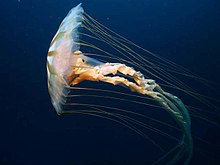Japanese sea nettle
| Chrysaora melanaster | |
|---|---|
 |
|
| Scientific classification | |
| Kingdom: | Animalia |
| Phylum: | Cnidaria |
| Class: | Scyphozoa |
| Order: | Semaeostomeae |
| Family: | Pelagiidae |
| Genus: | Chrysaora |
| Species: | C. melanaster |
| Binomial name | |
|
Chrysaora melanaster (Brandt, 1835) |
|
The northern sea nettle (Chrysaora melanaster), also called a brown jellyfish, is a species of jellyfish native to the northern Pacific Ocean and adjacent parts of the Arctic Ocean. (It is sometimes referred to as a Pacific sea nettle, but this name is also used for Chrysaora fuscescens; the name Japanese sea nettle was used for this species, but that name now exclusively means Chrysaora pacifica. This jelly's medusa can reach 60 centimeters in length with tentacles growing up to three meters. The number of tentacles is up to 24 (8 per octant). It dwells at depths of up to 100 meters, where it feeds on copepods, larvaceans, small fish, large zooplankton, and other jellies. The sting is mild, although can cause serious skin irritation and burning.
Life Cycle
Larval mature into adult body-form that releases eggs and sperm;Fertilized eggs settle to seafloor to produce a small non-colonial benthic form; Life span in Tokyo Bay is 1 year, how ever it is unknown in Arctic.
Habit
Open water of temperate northern Pacific Ocean, Arctic Ocean and especially the Bering Sea. Pollock can be the food of Chrysaora melanaster, it also can be the competitor for potentialy limited prey sources.
Influence from Climate Change The biomass of Chrysaora melanaster increased in recent years. Climate change caused a more stable and productive surface layer. The stable water column would also can contribute to the warmer surface later in summer in 1990s, which can cause Chrysaora melanaster growth and survival.
Japanese Sea Nettle Chrysaora pacifica
Japanese Sea Nettle, New England Aquarium
Swimming movement of the Japanese Sea Nettle, Albuquerque Aquarium
...
Wikipedia
